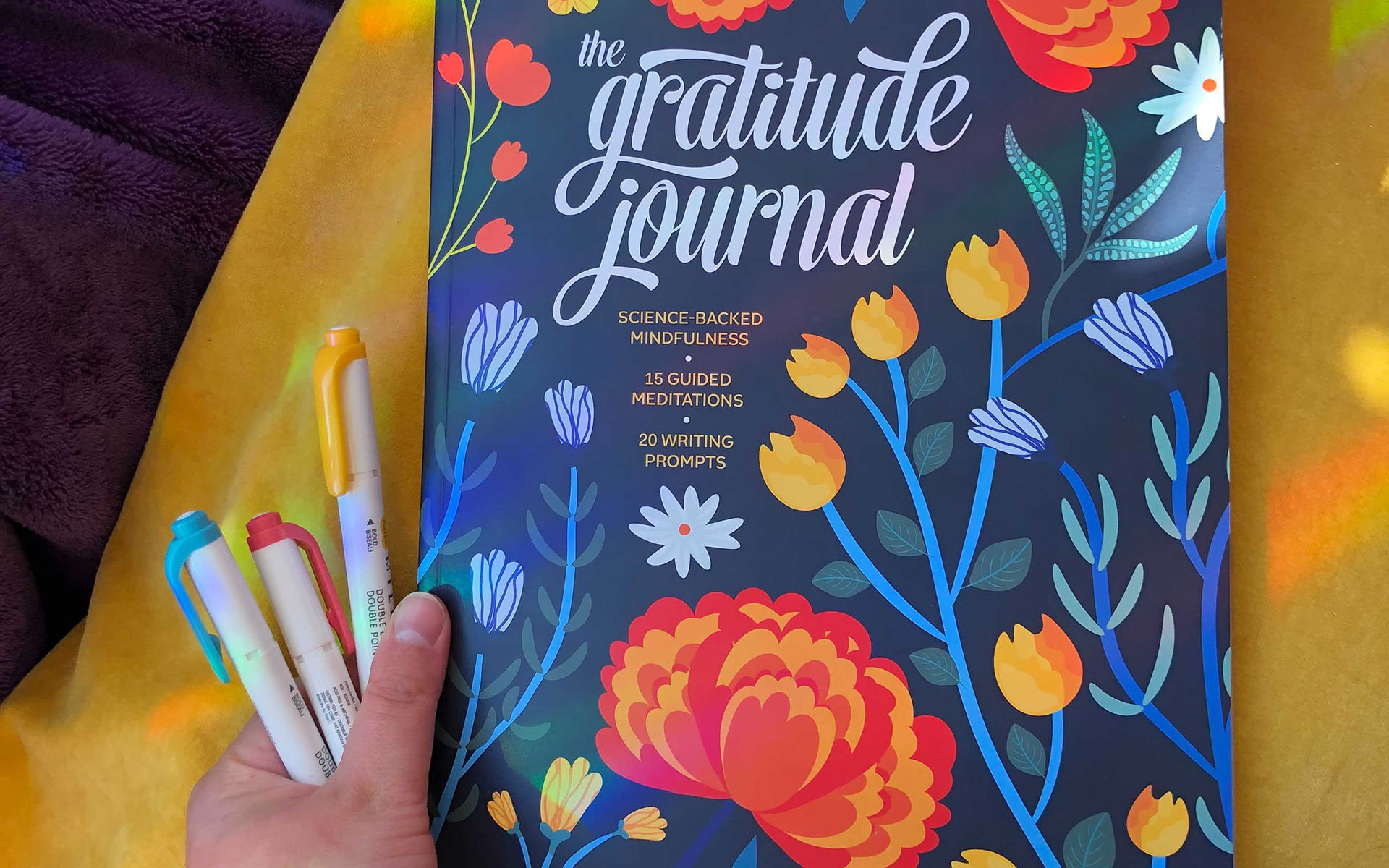
Practicing gratitude can be a game-changer: it has far reaching effects, from improving our mental health to boosting our relationships with others. Living your life with gratitude helps you notice the little wins—like the bus showing up right on time, a stranger holding the door for you, or the sun shining through your window when you wake up in the morning. Each of these small moments strings together to create a web of well-being that, over time, strengthens your ability to notice the good.
Building your capacity for gratitude isn’t difficult. It just takes practice. The more you can bring your attention to that which you feel grateful for, the more you’ll notice to feel grateful for!
- Start by observing. Notice the thank yous you say. Just how much of a habitual response is it? Is it a hasty aside, an afterthought? How are you feeling when you express thanks in small transactions? Stressed, uptight, a little absent-minded? Do a quick scan of your body—are you already physically moving on to your next interaction?
- Pick one interaction a day. When your instinct to say “thanks” arises, stop for a moment and take note. Can you name what you feel grateful for, even beyond the gesture that’s been extended? Then say thank you.

How Do I Practice Gratitude?
Robert Emmons, psychology professor and gratitude researcher at the University of California, Davis, explains that there are two key components of practicing gratitude:
- We affirm the good things we’ve received
- We acknowledge the role other people play in providing our lives with goodness
Most of us know it’s important to express thanks to the people who help us, or silently acknowledge the things we are grateful for in life. Research has linked gratitude with a wide range of benefits, including strengthening your immune system and improving sleep patterns, feeling optimistic and experiencing more joy and pleasure, being more helpful and generous, and feeling less lonely and isolated.
Interested in reaping some of these benefits? Get started with a gratitude practice.

Practicing Daily Gratitude
10 Ways to Practice Daily Gratitude
As Jon Kabat-Zinn says, “The little things? The little moments? They aren’t little.” Saying thank you, holding the door for someone, these little moments can change the tone of your whole day.
One of the most powerful ways to rewire your brain for more joy and less stress is to focus on gratitude. Here are 10 simple ways to become more grateful:
- Keep a Gratitude Journal. Establish a daily practice in which you remind yourself of the gifts, grace, benefits, and good things you enjoy. Recalling moments of gratitude associated with ordinary events, your personal attributes, or valued people in your life gives you the potential to interweave a sustainable theme of gratefulness into your life.
- Remember the Bad. To be grateful in your current state, it is helpful to remember the hard times that you once experienced. When you remember how difficult life used to be and how far you have come, you set up an explicit contrast in your mind, and this contrast is fertile ground for gratefulness.
- Ask Yourself Three Questions. Meditate on your relationships with parents, friends, siblings, work associates, children, and partners using these three questions: “What have I received from __?”, “What have I given to __?”, and “What troubles and difficulty have I caused?”
- Share Your Gratitude with Others. Research has found that expressing gratitude can strengthen relationships. So the next time your partner, friend or family member does something you appreciate, be sure to let them know.
- Come to Your Senses. Through our senses—the ability to touch, see, smell, taste, and hear—we gain an appreciation of what it means to be human and of what an incredible miracle it is to be alive. Seen through the lens of gratitude, the human body is not only a miraculous construction, but also a gift.
- Use Visual Reminders. Because the two primary obstacles to gratefulness are forgetfulness and a lack of mindful awareness, visual reminders can serve as cues to trigger thoughts of gratitude. Often times, the best visual reminders are other people.
- Make a Vow to Practice Gratitude. Research shows that making an oath to perform a behavior increases the likelihood that the action will be executed. Therefore, write your own gratitude vow, which could be as simple as “I vow to count my blessings each day,” and post it somewhere where you will be reminded of it every day.
- Watch Your Language. Grateful people have a particular linguistic style that uses the language of gifts, givers, blessings, blessed, fortune, fortunate, and abundance. In gratitude, you should not focus on how inherently good you are, but rather on the inherently good things that others have done on your behalf.
- Go Through the Motions. Grateful motions include smiling, saying thank you, and writing letters of gratitude. By “going through grateful motions,” you’ll trigger the emotion of gratitude more often.
- Think Outside the Box. If you want to make the most out of opportunities to flex your gratitude muscles, you must look creatively for new situations and circumstances in which to feel grateful. Please share the creative ways you’ve found to help you practice gratitude.
Try This 5-Minute Gratitude Meditation
Gratitude Practice: Savor The Moment—Elaine Smookler
- Savor the good. On days when gratitude feels difficult to find, tune into your senses. This meditation invites you to cultivate thankfulness by slowing down and noticing what you can see, hear, touch, smell, and taste. There doesn’t have to be anything special going on in order to practice gratitude—maybe it’s as simple as feeling grateful for your morning coffee, or for a good book. Explore this simple practice to appreciate the little things.
- Use the breath to anchor yourself in the present moment. Our minds are always so easily pulled to busyness. Bring particular attention to feeling the breath, or something in the body, as you bring your shoulders down and orient your attention toward gratitude.
- Next, bring to mind a sight you are grateful for. Move through your senses, and find one thing to start with that you appreciate that comes to you from the world of sight, if you have this available. It could be a color…a shadow…a shape…a movement. Remember, it will never be like this again. What do you see right now, and can you feel grateful that you get to see this, whatever it is?
- Now, shift to a scent you appreciate. As you continue to work with your senses, now take time to tune in with appreciation to an aroma. What do you notice? What about that glorious or interesting or subtle smell is making you smile? It could be gratitude for something familiar: a scent that brings comfort, upliftment; or maybe it’s something you’ve never smelled before, and it just piques your curiosity, ignites you, enlivens you.
- Moving on, tune into any sounds around you. Allowing the world of smell to gently recede into the background, on an in-breath, shift your attention to your ears and the world of sound. Maybe notice what it feels like to really listen. How many sounds can you notice, and can you feel grateful that you’re able to experience sound, if you are? What can you notice about these sounds—far away? close? Perhaps you could play a piece of music that brings you joy, and have gratitude that it’s so available? Or maybe it’s the sound of children laughing, the sound of loved ones breathing, the sound of the beating of your own heart.
- The world of touch and texture beckons us next. We find so much to be grateful for in touch! If there’s someone near who you can hug or who can hug you, notice how this makes you feel filled with gratitude for the joy of human contact. Or perhaps you have a beautiful pet that you can stroke and cuddle, or some lovely material with a texture that feels warm to the touch, soft, evocative. Let your senses ignite your gratitude! There’s so much to be appreciative of.
- Shift to noticing and appreciating objects around you. Now take a moment to look around: Look down, look up, and from side to side. Appreciate how much effort must have gone into anything at all you own or use. Someone conceived of the need and many people worked on the details of the design. Much care even went into the packaging to deliver your item to you safely. What do you feel when you let yourself be grateful that all that talent went into making your life a little easier?
- As you end this practice, carry this attitude of gratitude with you. One last little grateful tip: Why not offer your thanks to each person who does anything at all for you today? Even if it is their job to help you? When you’re grateful, when you let your heart open up and be filled with appreciation, notice how being grateful makes you feel.
- Close with gratitude. I’m so grateful that you tuned in to this gratitude practice, and I appreciate your time, your effort, and your energy to be present, awake, and alive to your precious life. Have a beautiful day.

Daily Gratitude Journaling
The practice of writing in a journal, a diary, or just scribbling notes to ourselves on pieces of paper, has both a rich history and present-day appeal. The famous 20th-century novelist and diarist Anaïs Nin believed writing serves “to heighten our own awareness of life…to taste life twice, in the moment, and in retrospection.” She was on to something. Writing has a remarkable way of shifting our awareness—keeping a journal can be an accessible way to experience that shift.
As a hobby, journaling is inexpensive, portable, and can brighten our quality of awareness, making sense of our thoughts, feelings, perspectives, our own developing story line as it happens. It gives us a chance to slow down, breathe, turn to a fresh page, and “get real” about what we’re thinking and feeling—also referred to, particularly in therapeutic settings, as expressive writing. Although we refer here to writing, journaling is not only about putting words on paper. Visual journals filled with sketches, doodles, or any form of art you desire, vastly expand the options and the accessibility of journaling practice. You don’t have to erase your doodles, correct your grammar, or worry about garnering Likes and emojis from a virtual fan club. In other words, expressive journaling is expressing yourself, for yourself.
How to Do It
There’s no wrong way to keep a gratitude journal, but here are some general ideas as you get started.
Write down up to five things for which you feel grateful. The physical record is important—don’t just do this exercise in your head. The things you list can be relatively small in importance (“The tasty sandwich I had for lunch today.”) or relatively large (“My sister gave birth to a healthy baby boy.”). The goal of the exercise is to remember a good event, experience, person, or thing in your life—then enjoy the good emotions that come with it.
9 Gratitude Writing Tips
As you write, here are nine important tips:
1. Be as specific as possible—specificity is key to fostering gratitude. “I’m grateful that my co-workers brought me soup when I was sick on Tuesday” will be more effective than “I’m grateful for my co-workers.”
2. Go for depth over breadth. Elaborating in detail about a particular person or thing for which you’re grateful carries more benefits than a superficial list of many things.
3. Get personal. Focusing on people to whom you are grateful has more of an impact than focusing on things for which you are grateful.
4. Try subtraction, not just addition. Consider what your life would be like without certain people or things, rather than just tallying up all the good stuff. Be grateful for the negative outcomes you avoided, escaped, prevented, or turned into something positive—try not to take that good fortune for granted.
5. See good things as “gifts.” Thinking of the good things in your life as gifts guards against taking them for granted. Try to relish and savor the gifts you’ve received.
6. Savor surprises. Try to record events that were unexpected or surprising, as these tend to elicit stronger levels of gratitude.
7. Revise if you repeat. Writing about some of the same people and things is OK, but zero in on a different aspect in detail.
8. Write regularly. Whether you write every other day or once a week, commit to a regular time to journal, then honor that commitment. But…
9. Don’t overdo it. Evidence suggests writing occasionally (1-3 times per week) is more beneficial than daily journaling. That might be because we adapt to positive events and can soon become numb to them—that’s why it helps to savor surprises.

Gratitude and the Brain
4 Ways to Train Your Brain to Practice More Gratitude
1. Take time to notice what’s around you
Practicing mindfulness helps you tune in to the present moment. It is possible that if you are a grateful person, you are more mindful of others’ gestures. The more often you tune into your awareness, the greater the chances you will notice all the good that’s around you to feel gratitude for, which can then bring satisfaction and happiness. Our ability to pick up on the beauty of nature, kindness from one another, the chance to make a living via a job, all require our ability to be cognizant of ourselves and our surroundings. Being mindful of help in the kitchen, or the color of the sky allows us to generate gratitude by simply noticing them.
2. Practice gratitude for the little things
We often remember to be grateful for big events, like graduating from university or getting married, but it can be more difficult to feel grateful for the small things we do every day. Reminding yourself that eating a meal, for example, is in itself special can be very powerful. Your immediate awareness of the food in front of you, combining flavors while removing hunger, is a great way to enjoy gratitude as often as you eat! Another example is feeling grateful in the morning for being able to comfortably sleep at night. We gain comfort, satisfaction and peace by practicing mindfulness and gratitude in this repeated fashion.
3. Share your gratitude for your loved ones
Most of us are a little bit guilty of taking our loved ones for granted. The next time you notice a kind act by a loved one, why not show gratitude by simply saying ‘thank you’ , or giving a hug? We ought to show appreciation and not let kind acts go unnoticed. Training yourself to show your gratefulness for loved ones can strengthen your relationships with others.
4. Spread gratitude via your social media platforms
Social media can feel so negative at times, but using it to share your gratitude can help create a more positive online atmosphere. For example, share an uplifting moment from a recent event or a lesson you learned from a book you read, or a photo of a place near you that you’re grateful for. Spreading good, and in a unique and uplifting way, is one way we each can do our part in this digital age to remind each other that we have a lot to be grateful for. Let us each inspire one another in this way.
Training our minds to practice gratitude more often is possible if we are mindful of ourselves, each other and our environment. Let us widen our circle of appreciation. Please share your ideas for reminding yourself to be grateful.
3 Ways Gratitude Benefits Our Brains
- It can help relieve stress and pain. The regions associated with gratitude are part of the neural networks that light up when we socialize and experience pleasure. These regions are also heavily connected to the parts of the brain that control basic emotion regulation, such as heart rate and arousal levels, and are associated with stress relief and thus pain reduction. Feeling grateful and recognizing help from others creates a more relaxed body state and allows the subsequent benefits of lowered stress to wash over us. (We recently published a scientific paper elaborating on these ideas.)
- It can improve our health over time. They are also closely linked to the brain’s “mu opioid” networks, which are activated during close interpersonal touch and relief from pain—and may have evolved out of the need for grooming one another for parasites. In other words, our data suggest that because gratitude relies on the brain networks associated with social bonding and stress relief, this may explain in part how grateful feelings lead to health benefits over time.
- It can help those with depression. Perhaps even more encouraging, researcher Prathik Kini and colleagues at Indiana University performed a subsequent study examining how practicing gratitude can alter brain function in depressed individuals. They found evidence that gratitude may induce structural changes in the very same parts of the brain that we found active in our experiment. Such a result, in complement to our own, tells a story of how the mental practice of gratitude may even be able to change and re-wire the brain.

The Science of Gratitude
Gratitude offers us a way of embracing all that makes our lives what they are. More than just a happy feeling for the parts of our lives currently going our way, gratitude encompasses the willingness to expand our attention so that we perceive more of the goodness we are always receiving.
In the past two decades, a growing body of evidence in the field of social science has found that gratitude has measurable benefits for just about every area of our lives. Gratitude appears to contribute substantially to individual well-being and physical health. So much so that the Greater Good Science Center at the University of California, Berkeley—a leader in research on the science of social and emotional well-being—describes gratitude as the “social glue” key to building and nurturing strong relationships.
Robert Emmons, professor of psychology at the University of California, Davis, and one of the world’s leading experts on the science of gratitude, defines gratitude as having two parts. The first is an affirmation of goodness: People can learn to wake up to the good around them and notice the gifts they have received. The second part of gratitude is recognizing that the source of this goodness rests outside of oneself—that we receive these gifts from other people, and sometimes from a higher power, fate, or the natural world. In other words, gratitude helps people realize that they wouldn’t be where they are without the help of others.
A Brain Built On Gratitude
Gratitude is more than just a momentary good feeling. Scientists who have studied written gratitude interventions, such as gratitude letters or journals, have found benefits for an individual’s mental health and well-being. Gratitude practices also appear to help you feel more satisfied in life and can boost your self-esteem, according to peer-reviewed research.
The Science: Feel Happier
In one study involving nearly 300 adults seeking counseling services at a university, one randomized group wrote a gratitude letter each week for three weeks. The gratitude group reported significantly better mental health (compared to the control group) at follow-up, 12 weeks after the last writing exercise. Another type of written gratitude practice is counting blessings, or “Three Good Things.”A study of this practice found that people who wrote down three things that had gone well in their day and identified the causes of those good things were significantly happier and less depressed, even six months after the study ended.
How It Works: Strengthen Positive Recall
How exactly do these practices work to improve our mental well-being?
In general, people are more cognitively aware of their “headwinds” (or barriers they face) than “tailwinds” (benefits they receive). By paying more attention to our tailwinds, studies have shown that we can accentuate feelings of happiness, optimism, and positive emotion.
“Strengthening your positive recall bias makes it easier to see the good things around you even when times are dark,” says Nancy Davis Kho, author of the book The Thank-You Project: Cultivating Happiness One Letter of Gratitude at a Time. Nancy set a lofty goal of writing 50 thank-you letters to people in her life and found that the practice improved her ability to weather some of life’s bigger challenges.
At first, Nancy found it difficult to come up with a list of 50 people. After she got started on the letters, the practice naturally boosted positive emotion and she was able to extend her gratitude well beyond her family and friends. Nancy encourages those writing gratitude letters to find “the creative people whose work carries you beyond yourself, whose vision helps you clarify your own, whose talent and hard work have combined to create a body of work that brings you simple joy.”
Why Practice: Deepen Resilience
Enduring gratitude is not just about happiness and positivity; it doesn’t require you to ignore or stifle negative emotions. In the book The Gratitude Project: How the Science of Thankfulness Can Rewire Our Brains for Resilience, Optimism, and the Greater Good, Robert Emmons writes that “practicing gratitude magnifies positive feelings more than it reduces negative feelings.” Gratitude helps you see the bigger picture and become more resilient in the face of adversity.
Nourish a Grateful Body
When digging into the science of gratitude, we begin to see there are more dimensions to this emotion than meet the eye. In the scientific literature, gratitude is studied in several different ways:
- Trait gratitude, which refers to whether people have a natu- rally grateful personality. Gratitude as a mood, which tracks daily fluctuations in gratitude.
- Gratitude as an emotion, which describes a passing feeling of gratitude (when receiving a thank-you letter, for example).
The “practice” of gratitude and the interventions that scientists use in their studies are activities designed to boost gratitude as a mood or emotion.
The Science: Boost Immunity and Heart Health
Research published in the last decade has shown that grateful people (those who have “trait gratitude”) have fewer common health complaints, such as headaches, digestion issues, respiratory infections, runny noses, dizziness, and sleep problems. It appears that practicing gratitude could also help to alleviate those pesky health problems. In one study, a group of college students who wrote about things they were grateful for once per week for 10 weeks reported fewer physical symptoms (such as headaches, shortness of breath, sore muscles, and nausea) compared to two other control groups.
How It Works: Calm the Nervous System
“Physiological changes associated with gratitude are typically a reduction in blood pressure and increase
in vagal tone, which is taken as an index of increased parasympathetic influence on the peripheral nervous system,” says Dr. Emiliana Simon- Thomas, Science Director at the Greater Good Science Center. The parasympathetic nervous system (the part of the nervous system that allows our body to “rest and digest”) can help you conserve energy by slowing the heart rate, stimulating digestion, and contributing to overall relaxation.
This soothing of the nervous system may be one mechanism by which gratitude works to calm the body. A study of heart-failure patients who were randomly assigned to either an eight-week gratitude-journaling group or a treatment-as-usual group found that patients in the gratitude group showed more parasympathetic heart-rate variability, which is a sign of better heart health.
Why Practice: Make Healthier Choices
Strange as it may seem, gratitude can also encourage us to fuel our bodies with nourishing foods. Research shows grateful people report better physical health because they tend to engage in healthy activities such as focusing on nutrition. “We have found that getting people to express gratitude could help them work toward healthier eating behaviors, like more fruits and vegetables and less junk food,” says Lisa Walsh, PhD, a postdoctoral research associate in social/personality psychology at University of California, Los Angeles, whose graduate studies included research with Sonja Lyubomirsky’s Positive Activities and Well-Being (PAW) Laboratory at the University of California, Riverside. In one of the PAW lab’s studies, high school students preselected a healthy eating goal and were asked to either write weekly gratitude letters or list their daily activities. Teens who expressed gratitude reported healthier eating behavior over time compared to those who just listed their activities. Other studies of people’s physical health outcomes have found that gratitude journaling can lead to better-quality sleep and lowered blood pressure.
Thankful to Those We Love
In addition to giving individual benefits, gratitude may also help to strengthen ties with friends, loved ones, and those in our wider communities. The find-remind-bind theory, first proposed by psychologist Sara Algoe—an associate professor at University of North Carolina at Chapel Hill—suggests that gratitude can help people identify good candidates for a new relationship (find), appreciate existing relationships (remind), and motivate people to maintain or invest in these relationships (bind). As Sara writes in a 2012 paper on her theory, “Gratitude starts inside one individual and its effects spread to a dyadic relationship and perhaps throughout a social network.”
The Science: Stronger Connections
“Social connection is likely key to well-being,” says Lisa Walsh. She explains that gratitude might not be an emotion that just makes people feel good; it appears to have social implications by motivating individuals to improve themselves. In an upcoming study from the PAW Laboratory at UC-Riverside, high school students who expressed gratitude had a mixed experience—they felt “elevated” (a positive emotion) and indebted. Immediately after writing their gratitude letters, the students also felt motivated to improve themselves.
Find-remind-bind theory suggests that expressing gratitude may prompt individuals to pay back the kindness they have received, and can also motivate a person to make decisions that will strengthen their relationships. Gratitude may increase a person’s desire to spend more time with someone, and it encourages prosocial behaviors.
How It Works: Better Communication
Gratitude also plays an important role in maintaining romantic relationships, acting as a “booster shot” to remind us why our partners are valuable and worth holding onto. By practicing gratitude, couples can initiate a cycle of generosity—one partner’s gratitude inspires the other to act in a way that reaffirms their commitment. One study found that receiving a thoughtful gesture from a partner was followed by increased feelings of gratitude and indebtedness. Experiencing gratitude from these acts of kindness led both partners to feel more connected and satisfied with their relationship the next day.
While many studies have examined the effects of writing gratitude, all the ways we communicate—letters, conversation, and social media—are avenues for expressing gratitude. Gratitude may also open the door to healthier communication styles within a relationship. Since the practice leads to more positive perceptions of our partners, friends, or family (and likely, greater trust), we may feel more comfortable talking through disagreements. In one study, participants who expressed gratitude toward a romantic partner or close friend reported greater ease when voicing relationship concerns in the future.
Why Practice: It’s Better Together
“Gratitude has made our family closer,” says Randi Joy, a chiropractor and life coach living in Ottawa. She’s been practicing gratitude with her family for about five years. “When we talk about our gratefulness and what we’re grateful for…we have a better connection,” she says. Whether it’s a gratitude walk where they discuss what they’re grateful for, or a list of their “gratefuls” at the dinner table, Randi’s family takes every opportunity to practice together.
Whether you hope to boost your mood and mental health, protect your physical health, or improve your personal relationships, a rich body of research in the field of social sciences has found that gratitude offers significant benefits. The takeaway: Cultivating gratitude can open the door to a different perspective-one that values the goodness in our lives. With practice, we can learn to see the bigger picture and navigate adversity with greater resilience.
Discover daily gratitude
The Mindful Gratitude Calendar
Bring the practice of gratitude into your daily life with this two-week journey inspired by our Gratitude Journal.
Read More
The Untapped Potential of Cultivating Gratitude at Work
Showing gratitude at work can contribute to a healthier workplace, but new research says that work gratitude is conceptually different from gratitude in other areas of our lives.
Read More
4 Ways Noticing What’s Present Can Boost Gratitude
Explore these quick reflections as ways to bring more awareness of gratitude to any moment.
Read More
Four Ways to Wire Your Brain for Gratitude
Gratitude can have a lasting impact on your well-being. Here’s how to foster it all day long.
Read More
share gratitude with others
Four Ways to Foster Gratitude in Children
Children who learn to practice gratitude are happier and more optimistic in the long run. Try this four-step practice to foster gratitude with your child.
Read More
Can Gratitude Help Couples Through Hard Times?
New research suggests that thanking our partners for supporting us through hardship may increase their joy and satisfaction in giving.
Read More
How a Lack of Gratitude Kills Relationships
A new study suggests that couples who express gratitude are more satisfied with their relationship.
Read More









